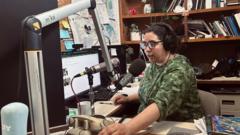A severe winter storm last year in Kotzebue, Alaska, put local journalist Desiree Hagan in a position reminiscent of a life-or-death battle. Despite the blinding snow and frigid temperatures, Hagan, the sole U.S. journalist stationed within the Arctic Circle, made her way to the KOTZ public radio station. "The snow was so intense you could not see in front of you," she recalled. Given her unique position, Hagan knew her reporting was critical during the crisis: "It’s go time, I have to report on this." With flooding and power outages threatening local residents, Hagan's work provided essential updates on shelters and safety measures.
In stark contrast, a contentious vote in Washington could end federal support for public broadcasting. The Senate is poised to decide whether to scrap $1.1 billion from the Corporation for Public Broadcasting, a funding body for public radio and television. This funding is vital for many local stations, including KOTZ, where federal funds account for 41% of its revenue. With over 70% of federal funding directed at local media outlets, these cuts could be catastrophic for rural coverage across the United States.
Former President Donald Trump has long championed defunding public broadcasters like NPR and PBS, branding them as biased. Despite long-standing criticism, executives maintain that they adhere to rigorous journalistic standards. Yet, many Republican voters express distrust of these outlets. This proposed funding elimination may particularly harm community-based stations, as rural broadcasters often receive significant income from federal grants, making them vulnerable to sweeping budget cuts.
Senatorial discussions surrounding these cuts reveal unease, especially among Republicans representing rural states that benefit from public media. Senator Lisa Murkowski of Alaska remarked that these outlets serve an indispensable role: "what may seem like a frivolous expense to some has proven to be an invaluable resource that saves lives in Alaska." Others, like Congressman Dan Goldman, co-chair of the Public Broadcasting Caucus, caution that public media cuts are not guaranteed to pass due to the threats they pose to crucial local journalism.
Experts warn that the lack of federal funding would disproportionately affect rural areas, which are already facing dire news deserts. According to Northwestern University, the number of counties with no local news coverage has ballooned to 206, leaving 1,561 counties reliant on a single news source—thus, rural communities are at risk of losing their connection to timely information altogether.
In West Texas, Travis Bubenik, the news director at Marfa Public Radio, expressed concern for the future, saying, "It's scary…this station might be either off the air or just not able to do the same quantity and quality of local news." With more than a third of its funding tied to federal grants, Marfa Public Radio's ability to serve a predominately Republican audience could hang in the balance.
In Kotzebue, Hagan, with her audience largely composed of Inupiat community members, remains hopeful for a better outcome. Despite the uncertainty, she acknowledges the crucial role of KOTZ: "The station is so interwoven into the community… These cuts would have ripple effects across every aspect of society." She adds, "It would be devastating." As the deadline for the Senate vote looms, communities are left anxiously awaiting news that could alter the landscape of rural journalism and their access to vital information.





















